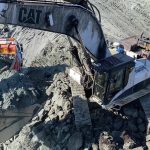Descriptions:
*Restoring the Land: Caterpillar D9T Bulldozers in Mine Rehabilitation*
In today’s YouTube video, we’re taken to a sprawling mining area, where two Caterpillar D9T bulldozers are hard at work rehabilitating a section of the site. While the sight of bulldozers moving massive amounts of earth is impressive, what makes this scene truly remarkable is its purpose: restoring the land after mining operations have ceased. This blog explores the rehabilitation process in abandoned mines, highlighting the role of powerful machinery like the D9T bulldozers in transforming scarred landscapes into sustainable environments.
*The Scene: A Huge Mining Area*
The video begins with a sweeping view of the vast, exposed land that was once the center of mining activity. The area shows the characteristic marks of large-scale mining, including terraced pits and displaced earth. Now, with the extraction work complete, the focus shifts to rehabilitating the mine site, a critical step toward environmental recovery and sustainability.
Enter the Caterpillar D9T bulldozers—formidable machines built for heavy-duty earthmoving. In this video, these bulldozers are reclaiming the land, pushing tons of soil and debris into place, leveling uneven terrain, and preparing the ground for its next stage of restoration.
*The Caterpillar D9T Bulldozer: A Tool for Transformation*
The Caterpillar D9T bulldozer is a titan in the world of heavy machinery, equipped with a powerful engine, robust undercarriage, and advanced blade technology. It is specifically designed for demanding tasks like those required in mine rehabilitation.
In the video, the bulldozers work in tandem, systematically shaping the land to restore its natural contours. The D9T’s precision and power allow the operators to handle the enormous volumes of displaced material efficiently, smoothing the ground and filling in pits and trenches left by the mining process. The result is a surface ready for the next steps in the rehabilitation plan.
*The Mine Rehabilitation Process*
Rehabilitation of mining sites is a vital process aimed at mitigating the environmental impact of mining and ensuring the land can support new uses, whether for agriculture, wildlife, or human activities. Here’s an overview of the key stages in mine rehabilitation:
Recontouring the Land The first step is to recontour the site, restoring the natural shape of the landscape. Bulldozers like the Caterpillar D9T are critical in this phase, as they move vast amounts of soil and debris to fill pits and stabilize slopes. This step ensures the site is safe and erosion-resistant.
Topsoil Replacement Once the land is leveled, topsoil—often stockpiled during initial mining operations—is redistributed across the site. This layer of fertile soil is essential for supporting plant growth and fostering biodiversity.
Revegetation After the topsoil is in place, the area is seeded with native plants or trees, chosen to match the local ecosystem. This step helps prevent soil erosion, improves water retention, and provides a habitat for wildlife.
Water Management Proper drainage systems are implemented to manage water flow and prevent contamination. Old mining pits might be repurposed as water reservoirs, or wetlands can be created to support local ecosystems.
Long-term Monitoring Once the immediate rehabilitation work is complete, the site is monitored for years to ensure the ecosystem is recovering as planned. Adjustments may be made to address unforeseen issues, such as invasive plant species or erosion.
*Why Mine Rehabilitation Matters*
Mining is essential for extracting resources that power industries and economies, but it often leaves behind a significant environmental footprint. Mine rehabilitation is crucial for:
Restoring Ecosystems: By recreating natural habitats, rehabilitation allows flora and fauna to thrive once again in areas that were heavily disturbed.
Preventing Environmental Hazards: Stabilizing the land and managing water flow reduce the risk of landslides, erosion, and water pollution.
Supporting Sustainable Development: Rehabilitated sites can be repurposed for agriculture, forestry, or recreational activities, creating value for local communities.
*Building a Better Future*
Today’s video offers a powerful reminder of the importance of rehabilitation in mining operations. Watching the Caterpillar D9T bulldozers methodically transform the landscape is both inspiring and reassuring.
@MegaMachinesChannel Is Ready To Travel All Over The World And Make Videos.
Appropriate content for children and kids (family safe).
🌐 𝗵𝘁𝘁𝗽𝘀://𝘄𝘄𝘄.𝗺𝗲𝗴𝗮𝗺𝗮𝗰𝗵𝗶𝗻𝗲𝘀𝗰𝗵𝗮𝗻𝗻𝗲𝗹.𝗰𝗼𝗺/
📧 𝗶𝗻𝗳𝗼@𝗺𝗲𝗴𝗮𝗺𝗮𝗰𝗵𝗶𝗻𝗲𝘀𝗰𝗵𝗮𝗻𝗻𝗲𝗹.𝗰𝗼𝗺
𝐒𝐔𝐁𝐒𝐂𝐑𝐈𝐁𝐄 – 𝐈𝐭𝐬 𝐟𝐫𝐞𝐞 𝐚𝐧𝐲𝐰𝐚𝐲 😄
https://www.youtube.com/c/MegaMachinesChannel
Dig In for More Content 👇:
🔵 https://www.facebook.com/megamachineschannel
🔵 https://www.instagram.com/megamachineschannel/
🔵 https://www.tiktok.com/@megamachineschannel
#megamachineschannel #bulldozer #dozer #mine #caterpillard9t














